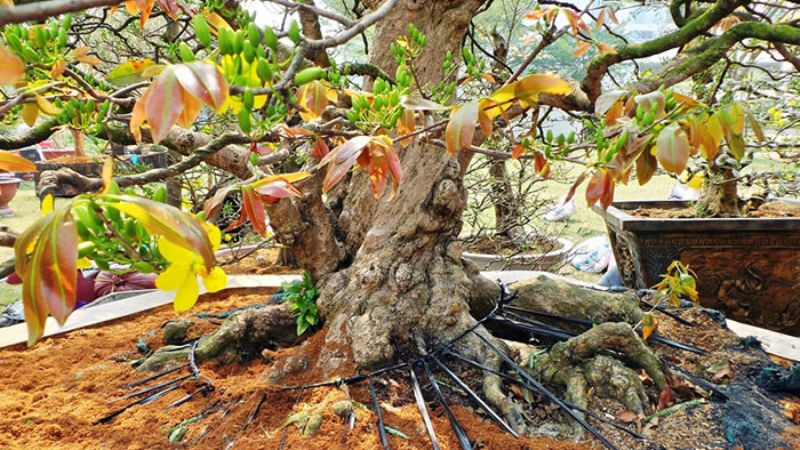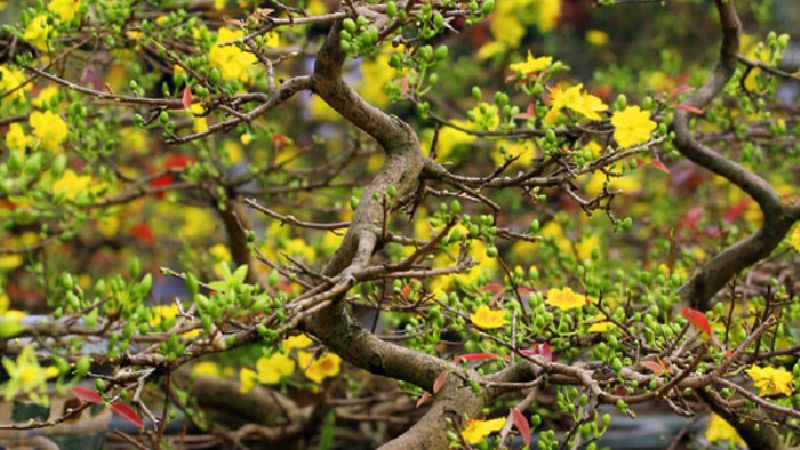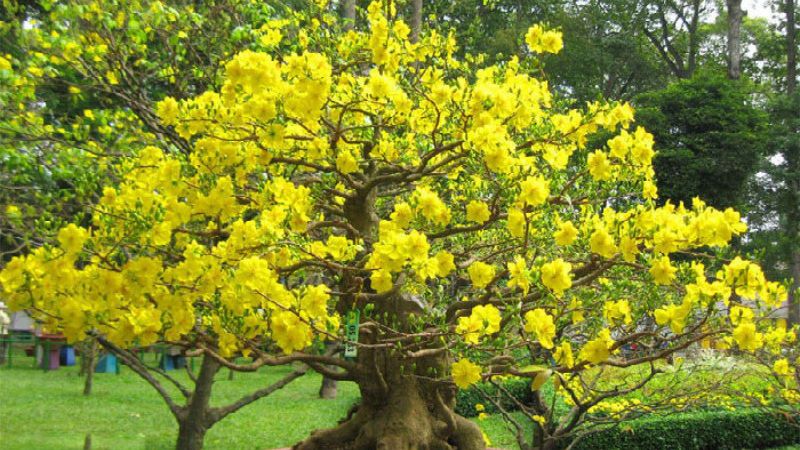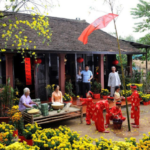The apricot blossom, or Ochna integerrima, is a symbolic flower for the Vietnamese people, especially during the Tet Holiday. Every year, Vietnamese families, especially those in the Southern regions, will choose the most beautiful apricot branches and pots to decorate their homes and offer to their ancestors.
According to ancient beliefs, the apricot flower represents a resilient life, enduring through hardships, and its golden color symbolizes wealth and prosperity. An apricot flower that blooms on the day of Tet is considered especially auspicious, foretelling a year of good fortune and prosperity.
Therefore, it has always been a tradition to select an apricot tree that will bloom on the day of Tet, with the hope of inviting good luck into the house. Experienced apricot enthusiasts often follow the criteria of “first the root, second the trunk, third the branches, and fourth the buds” when choosing a tree.
Related: Tips to care for your apricot tree so it will bloom again next year
1 First, the Root
The “root” refers to the base and the root system of the apricot tree. A healthy root system is the most important factor in determining the tree’s overall well-being. A strong root system will support the trunk and ensure the tree’s longevity.
When choosing an apricot tree, look for those with roots that slightly protrude above the ground but not excessively, forming a moderate, non-entangling shape. Excessive entanglement can create a messy appearance, detracting from the tree’s aesthetic value.
The root should be wider than the trunk, and the base of the tree should have some knobs and deep indentations. These seemingly rugged features are indications that the tree has endured harsh conditions and still stands strong. Whether it’s a young or old tree, these characteristics are desirable.
 First, the Root
First, the Root
2 Second, the Trunk
The trunk is the second most important aspect, as it often draws a lot of attention. A tree’s beauty is greatly influenced by the shape of its trunk.
For young apricot trees, the trunk should be round, sturdy, and smooth, without any peeling bark. The tree should grow straight, without any twisting. If there are any knots or bumps, they should be aesthetically pleasing. The trunk should be thicker than the branches but thinner than the root to maintain a harmonious shape.
 Second, the Trunk
Second, the Trunk
For older apricot trees, the trunk should have a graceful curve and a textured appearance. The bark should be rough, with some indentations, and the root should be wide, resembling an ancient tree.
 The bark should be rough, with some indentations, and the root should be wide, resembling an ancient tree.
The bark should be rough, with some indentations, and the root should be wide, resembling an ancient tree.
3 Third, the Branches
When choosing an apricot tree, look for one with well-distributed branches that create a harmonious silhouette. The branches should grow long and straight, without any downward bending or twisting. Ideally, the higher you go, the shorter and thinner the branches become.
A healthy apricot tree will have sturdy, well-arranged branches with fresh, new leaf buds. If the tree has too many green leaves, remove some of the larger ones.
The lowest branch near the root should not be too close to the ground, as this will obscure the beauty of the root. An ideal distance is between 10 and 15 cm.
Avoid choosing a tree with branches showing signs of insect damage. Even a single affected branch can allow insects to spread to the rest of the tree, leading to its demise. Similarly, refrain from purchasing a tree with dry, leafless branches, as this will detract from its overall beauty.
 Third, the Branches
Third, the Branches
4 Fourth, the Buds
Since the main attraction of the apricot tree is its flowers, the buds are just as important. Experts advise against choosing a tree that has already fully bloomed. Instead, opt for a tree with a few open flowers and plenty of buds.
The buds should be plump and not too green or newly sprouted to ensure they bloom during Tet. They should be evenly distributed across the branches, and there shouldn’t be too many, as this can deplete the root’s nutrients, causing the flowers to wither faster.
For the flowers that have already bloomed, look for large, evenly-shaped petals. Traditionally, an apricot flower with five petals is considered ideal, symbolizing the five elements of “metal, wood, water, fire, and earth.” However, today’s market offers varieties with more petals, allowing homeowners to choose according to their preferences.
 Fourth, the Buds
Fourth, the Buds
blooming on Tet is a common question among those who wish to purchase apricot trees for the holiday. We hope that this guide will assist you in selecting the perfect apricot tree for your family.
8 Traditional Games to Bring Family Fun to Tet Holiday at Home
 Tet Holiday at Home’>
Tet Holiday at Home’>As the Lunar New Year approaches, many families are preparing to celebrate with festive traditions and activities. To honor this time-honored event, let’s take a look at 8 fun traditional games that can be easily enjoyed at home with friends and family.


































